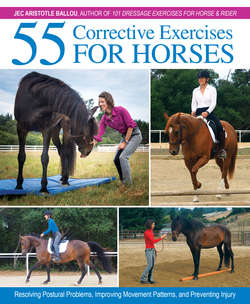Читать книгу 55 Corrective Exercises for Horses - Jec Aristotle Ballou - Страница 14
На сайте Литреса книга снята с продажи.
Why Ground Poles?
ОглавлениеSchooling horses over ground poles, whether in hand or from the saddle, which we’ll do in many exercises in this book, can cure numerous gait irregularities or movement compromised by tension, crookedness, and weak muscle patterns. Because they require the horse to take designated stride lengths in sequence, they install good clear rhythm in all gaits. As the horse traverses over poles, he learns to push equally from both hind legs, correcting imbalances in the effort of his hind limbs. Pole work contributes to straightness and symmetry through his core and mobilizes the spinal joints.
The postural adjustments needed for crossing poles recruit the horse’s interconnected abdominal muscle group, thoracic sling, and gluteal chain. Schooling different arrangements of poles helps re-pattern existing habits within each gait, and leads to the creation of new signals from the nervous system.
• As a general rule, walking over raised poles improves core stability, joint flexion, and intervertebral joint spacing. It assists horses recovering from sacroiliac pain, back injury, or disrupted muscle use from stiffness. Walking over poles contributes to the horse’s looseness and range of motion.
• Trotting over poles plays more of a strengthening role. It develops strength in the larger back muscles that effect limb movement plus utilization of quadriceps, pelvic stability, and stronger spinal stabilizing muscles. As these muscles are recruited, it can lead to a release of stored tension from the extensor muscle chain, which is a common culprit of horses that tend to be chronically hollow in their toplines.
• Cantering over poles tones the thoracic sling, loosens the shoulders as the body rocks between forehand and hindquarters, and lifts the back. It can greatly improve flexion and extension of the back, which allows it to lift and carry the rider better. It is believed to deliver the most mobilization of the lumbosacral joint, which enables the horse to engage his hind limbs.
Setting up ground poles can seem like an arduous task, which leads many riders to avoid it, but with some creativity, it does not need to be. First of all, to promote your own consistency using poles, I recommend buying six to eight poles that are easy to move around and set up. This way you are far more likely to use them. If you try instead to use heavy or excessively long poles, you are far less likely to use them regularly. Unless you jump on a regular basis, I suggest using something else besides jump poles. You do not need anything fancy, but just something that is easy enough to use that you will do so consistently.
fit tip
When soft tissue is healing, the new tissue needs to be educated on its job. The overall process of getting a soft-tissue injury successfully back to competition involves 25 percent treatment and 75 percent rehabilitation process.
One of my favorite options is to use 4-inch by 4-inch redwood or cedar posts that are flat on one side—easily found in the landscape section of your local hardware store. I like them because they are sturdy but lightweight. They lie flat without rolling around and are easy to set up. In my travels, I have seen riders using other types of lightweight poles or creative variations.
To summarize: do not forego ground pole work because you think you might not have the ideal supplies. Look around and use what you have handy.
